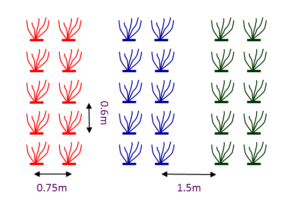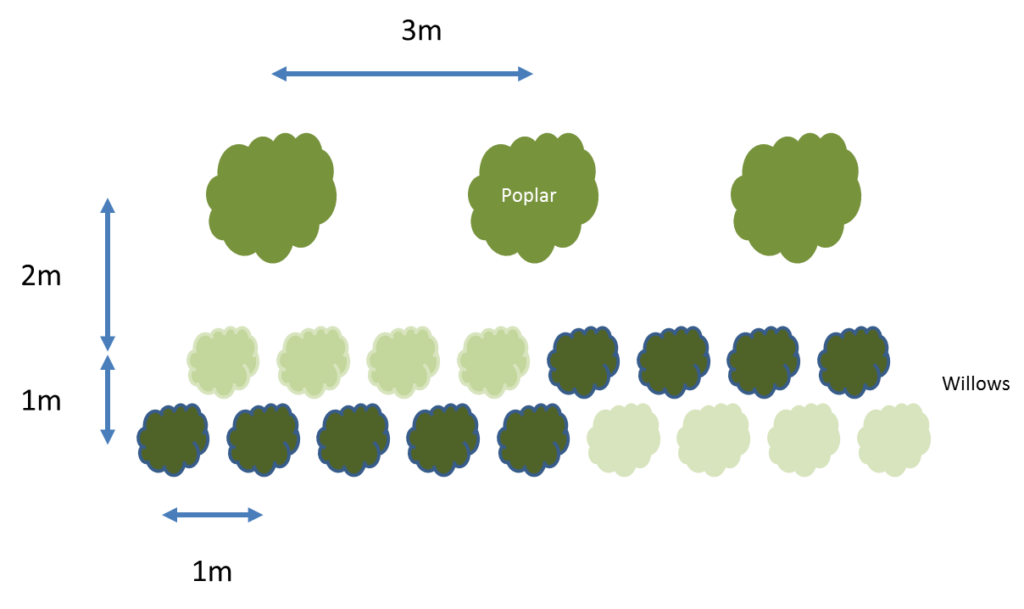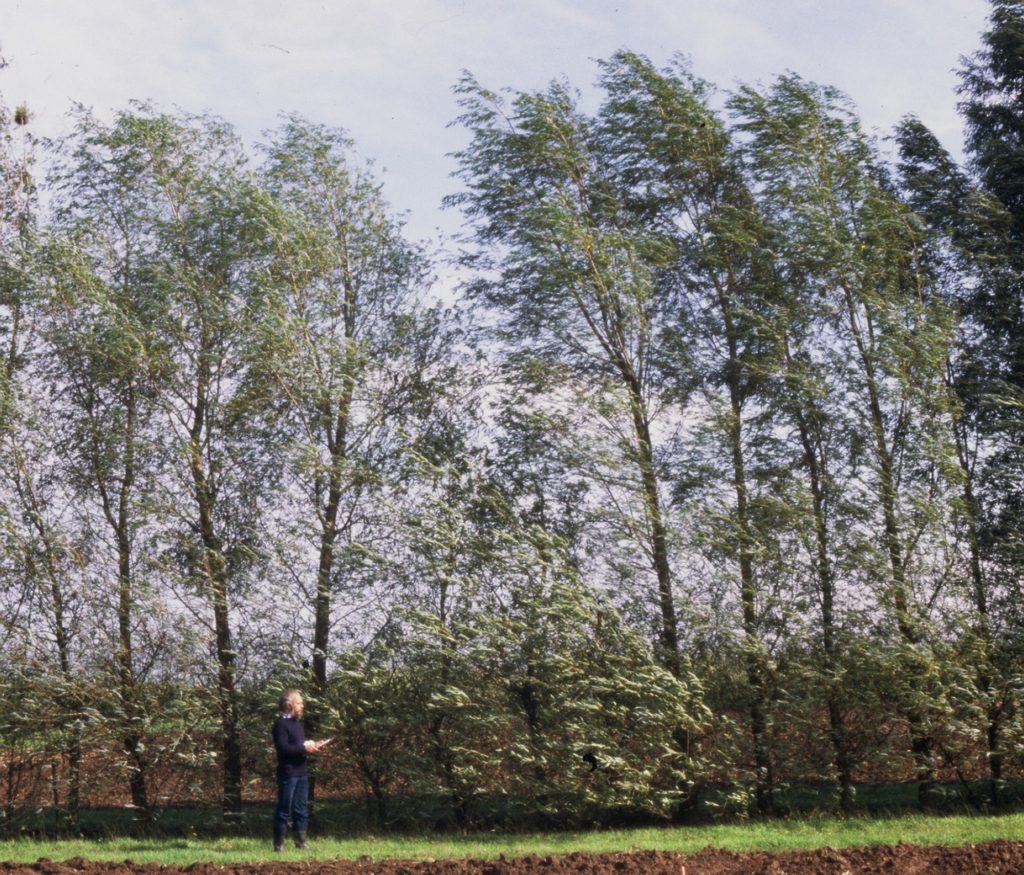Energy Crop Plant Spacings & Stocking Densities
There are countless permutations for spacing different energy crops in order to get the best results. The distances between plants and the stocking density choosen depends on a number of factors:
- The energy crop involved
- The rotation length over which it will be harvested
- Whether the crop will be harvested mechanically or manually
- Ease of access for harvesting
- Space required for animals if using as shelter
- Staggered rows in order to maximise shelter, screening or as a preventative barrier
Here are some typical examples:
Commercial SRC willow
Stocking density ~15,000 per hectare. This is achieved by mechanised planting and is designed for mechanised harvesting every 2-3 years. There are twin rows (0.75m apart) with wide spaces (1.5 m apart) for tractor wheels to travel up. Within the rows there is usually a 0.5 – 0.6m gap. Often contractors plant closer together in the row in order to factor in some losses – i.e. you plant at 18,000 in order to achieve 15,000 per hectare.
This is the perfect layout for biomass chip production and biofiltration. The close spacings increase speed to canopy closure and reduction in competition from weeds.
Variations
If you want to maximise wildlife then periodically leave a 2-3m ride running up the plantation. More birds are attracted to the canopy edge. This also provides good cover for game birds.
Manually planting and harvesting of willow and poplar
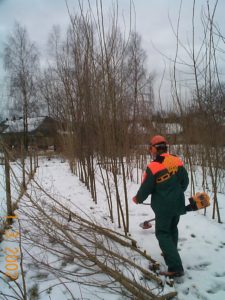
You need space to work for manually harvesting SRC willow and poplar. There’s 2 metres between these poplar rows. I would consider even going for 3m gaps.
If you are going to engage with this activity then I would recommend leaving yourself ample space to work. You’re going to have to get access to the base of the stool with a brushcutter or chain saw. The 1.5 m gap between rows (above) is probably not enough as willows and poplars will chase the light and fill this gap easily. I would suggest 3m between rows and 0.5m within the row. This will give a stocking rate of 6,600. As you are leaving lots of open ground it might be worth investing in geotextile membrane as this will help suppress weeds immediately around the stool.
Even though the trees are crowded in the rows there will be plenty of room for them to grow out sideways and for you to get in and cut when required. The likely rotation length is probably going to be 5 years but you will get good log diameters from the coppiced stems.
Remember, that if you are planting for log production you want to harvest a proportion each year. If you have a 5 year rotation and have 1 hectare to play with then plant 0.2 ha each year for 5 years and then harvest 0.2 hectare per year from year 5.
Bear in mind that willow will want to coppice and given space will produce side shoots. It is possible to plant SRC willows and poplars as long rods. This will produce better logs and less processing at harvest as long as you are prepared to rub out side shoots.
Miscanthus for bioenergy and bedding
 In the past the suggested stocking rate was 10,000 per hectare 1m x 1m spacings. Unfortunately, although most rhizomes will establish you can’t guarantee it. Hence, a better practice is to plant at 20,000 per hectare (0.5 m x 1m). This will lead to a much less patchy crop with a higher yield. It’s more expensive to establish but the extra up front cost is well worth it over a 20 year horizon.
In the past the suggested stocking rate was 10,000 per hectare 1m x 1m spacings. Unfortunately, although most rhizomes will establish you can’t guarantee it. Hence, a better practice is to plant at 20,000 per hectare (0.5 m x 1m). This will lead to a much less patchy crop with a higher yield. It’s more expensive to establish but the extra up front cost is well worth it over a 20 year horizon.
Variations
If you are planting for game cover then plant more widely. 1m x 1m spaces are fine but have rides every 5-10 metres. This should work well for poultry rearing for shelter.
Short Rotation Forestry – natives
If you are planting natives and naturalised species (e.g. birch, alder, poplar) as SRF then go for a 5,000 per hectare spacing. Plant at 2m x 1m spacings to achieve this and harvest over 8-12 year rotations depending on the growth rate. If this is deemed too costly then you can plant more widely (e.g. 1.5m x 1.5 m is ~4,400 ha) but there is more likely to be more weed competition and lower yields.
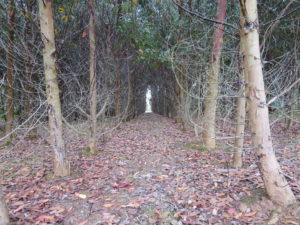
Eucalyptus spaced at 2m in the row and 3m between rows. 1,650 plants per hectare. This plantation in south Devon is 5 years old !
Short Rotation Forestry – exotics
For faster growing exotics such as Eucalyptus species then go for a 1,650 plants per hectare. This can be achieved by a 2m x 3m spacing. On good sites with good weed control with low deer pressure you should be thinning after 5 years and harvesting after 8 years.
Broadleaved coppice
This tends to involve less vigorous tree species grown over longer rotations (12-20years). 2,500 plants per hectare is the norm with spaces of 2 m x 2m. There can be a biomass element to this management regime but the yields will be a lot lower.
Willow and miscanthus screens
Both willow and miscanthus provide very effective screens. The choice depends on height, colour and the appearance in winter. Biomass willow can grow to 7-8 metres over 3 years. If that’s too tall then consider a colourful basket making variety instead. If you want the height then plant a few different varieties together in order to provide colour variation – Terra Nova, Endurance and Endeavour have great colour contrast. The first two keep their leaves long into the winter but all three have lots of stems so even a screen that is only three rows deep with staggered planting (0.5 m x 0.5 m) will screen an unruly looking eyesore. Of course you will have to factor in that you will periodically have to cut the screen down. Do this in late winter. This is the best time to enable quick drying of the wood but also the coppice will romp away in the spring and you’ll have your screen back I place in a matter of weeks.
Miscanthus is very dense and gets to 3m in height by the end of the year. We only sell Miscanthus x giganteus so the screen will be uniform in colour. Greenish in the summer and beige/green in the winter. Two to three rows of this will provide an effective screen again planted at 0.5 x 0.5m spacings in staggered rows. As miscanthus grows from the base each year you can leave last year’s straw in place. However, That will probably look ugly so it’s probably a good idea to cut it back in April. Like willow, the crop will romp away in the spring. With Miscanthus you will see the thing you are wanted to screen at some point evergy year. With willow, you will see it every third year.
If you don’t want to ever see the thing you are trying to hide consider a combination of miscanthus and willow. You should be able to time the cropping so there is always something shielding you from the horrors beyond!
Windbreaks
Willows and poplars can work well together as a very effective windbreak reduce which can reduce wind speed for 600m downwind. These are great for orchards or campsites. Closely planted willows and more widely spaced poplars will certainly do the trick!
